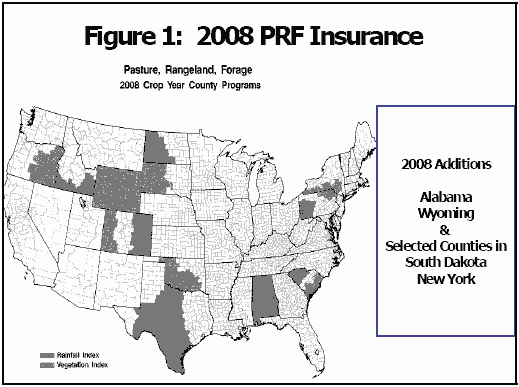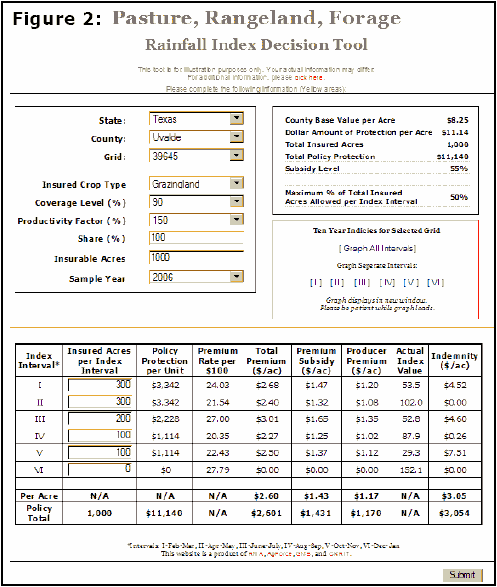AG-ECO NEWS
Vol. 23, Issue 33, November 20, 2007
Jose G. Peña
Extension Economist-Management
Pasture, Rangeland, Forage Risk Management Insurance November 30, 2007 Sales Closing Date For 2008 Policies
The November 30, 2007 closing date is rapidly approaching to purchase or to make changes to policies in the government subsidized Pasture, Rangeland and Forage risk management pilot insurance programs for 2008. Policies are available through local crop insurance agents. Producers who enrolled for 2007 will be automatically rolled-over into 2008, unless the producer cancels or changes the policy.
The USDA-Risk Management Agency (RMA) introduced this program last year for the 2007 crop year. On September 6, 2007, RMA announced the expansion of the program to additional states and counties for the 2008 crop year. (See Figure 1).

Very little has changed with the fundamental mechanics of the insurance. Livestock producers may purchase insurance protection for losses of forage produced for grazing or harvested for hay. Insurance programs are based on an index of vegetation greenness or on a rainfall index, depending on what state/region. Only the rainfall index program is being offered in Texas.
The rainfall index program, which was tested in 2007 in specific counties in Colorado, Idaho, Pennsylvania, South Carolina, North Dakota and Texas, has been expanded to include the entire state of Alabama. The vegetation greenness program that was piloted in specific counties in Colorado, Oklahoma, Oregon, Pennsylvania, South Carolina and South Dakota has expanded to include the entire state of Wyoming and specific counties in South Dakota and New York.
Ranchers in Texas responded very positively to this program in 2007 with 5,927 policies underwritten, covering 20.9 million acres (73% of all U.S. insurable acreage; 89.2% of Rainfall Index program acreage). Producers in Texas protected about $265 million in potential value for about $22.3 million in premiums (premium costs less subsidies). As of November 13, 2007, about $393,100 had been paid in indemnity payments for 2007.
Insurance Concept
The rainfall index program measures losses based on the amount of rain received in a given interval, compared to a pre-determined rainfall index. The vegetation greenness program is based on satellite imagery that determines the greenness value of the range, helping to analyze range condition as a means to measure expected production losses.
Both the vegetation and the rainfall index programs are based on protecting the income potential of an insured plot. Producers are not required to insure all their acres. They may elect to insure only those acres that are important to their grazing program or hay operation and do not have to insure the acreage for the entire crop year. For the rainfall index program, the crop year is divided into two-month intervals. Producers may elect to insure their acreage for only those intervals where the risk of the low normal rainfall is the greatest.
Rainfall Index
The rainfall index program is for a single peril, lack of precipitation. The program covers potential losses of grazing and/or haying. Producers are not required to insure all their acres. They may elect to insure only those acres that are important to their grazing program or hay operation. The crop year for the rainfall index program begins February 1 and is divided into two-month intervals. Producers may elect to insure their acreage for only those intervals where the risk of below normal rainfall is the greatest. The rainfall index program measures losses based on the amount of rain received as determined by the National Oceanic and Atmospheric Administration (NOAA) in a given interval and grid, compared to the historic average rainfall for the same interval and grid. Each insurable county is divided into 12×12 mile grids and each grid is then assigned a rainfall index based on historical rainfall records (1948-2005) kept by NOAA. Each county within the pilot area has been assigned a productivity value per acre i.e., the potential income per acre that the rainfall could generate has been determined for each county. For example, the productivity value per acre in Uvalde County is $8.25/acre. However, this value does not reflect an individual producer’s management of the land resources. To tailor this productivity value, a producer may elect to adjust this productivity by choosing from 60% to 150% of this value based on his/her perception of the productivity of the plot being insured. In effect, the producer tailors the value to fit his own acreage management, such as past brush or weed control plans. Finally like most insurance programs, producers may elect insurance protection of 70%-90% (in 5% intervals) of the posted rainfall index.
The crop production year is divided into six 2-month intervals (Intervals: I-Feb-Mar, II-Apr-May, IIIJune-July, IV-Aug-Sep, V-Oct-Nov, VI-Dec-Jan). Producers must select at least two, 2-month time periods in which precipitation is important for the growth and production of the forage species, e.g., April-May for spring and August-September for Fall. NOTE: For the Rainfall Index program in Texas, not more than 50% or less than 10% of the acres may be entered in any one of the intervals selected for insurance coverage and the sum of the acres by interval cannot exceed the total insurable acres.
Insurance indemnity payments to a producer are calculated based on the deficit from normal precipitation within the grid and index intervals selected.
A Recipe to Calculate Premiums and Coverage
While program details can be obtained and insurance policies purchased through local crop insurance agents, the following is a recipe for the use of an internet based decision aid tool to determine approximate premium costs and coverage:
1) Find your 12×12 mile grid – Go to http://www.rma.usda.gov/policies/pasturerangeforage/

Under the Rainfall Index, Grid Id Locator, click on Interactive Map. (NOTE: the initial grids shown are around College Station). There are several ways to find your grid. Probably the easiest and fastest method is to type in the closest city to your ranch, in the left center of the screen under “Type a city name and click FIND.” For the purpose of this example, type in Uvalde and click FIND. Confirm the city if more than one option appears.
2) Move the map left/right/up/down with the arrows on the borders of the map to locate your ranch.
3) Center the grid which includes your ranch. For the purpose of this example, center map on grid #39645, Uvalde.
4) Click on item #2, Decision support tool under “View data of this location”, on the lower left corner of the screen. NOTE: You can check the Historical rainfall indices for this site by clicking on item #3
5) A worksheet will come up after clicking on item #2. Fill out the blank spaces and click on Submit Query on the lower right corner.
NOTE: The program allows a user to check the amount of an indemnity (if paid) for each of the 60 years from 1948 to 2007. For the purpose of this example, select 2006 as the sample year.
Table 1 provides a summary of the cost/benefit relationship of insuring 1,000 acres of grazingland in Uvalde, TX (grid# 39,645) at 90% of the rainfall index and 150% of the productivity value factor, with 300 acres in Interval I (Feb-Mar), 300 acres in Interval II (Apr-May), 200 in Interval III (Jun-Jul), 100 acres in Interval IV (Aug-Sep), 100 acres in Interval V (Oct-Nov). No insurable acres were entered in Interval VI (Dec-Jan). Please note that 2006 was selected as the sample year to see if an indemnity would have been paid. After submitting the Query, the upper right hand box provides a Summary of County Base Value per Acre, the Dollar Amount of protection per acre, Total Insured Acres, Total Policy Protection, and the Subsidy Level. The last two lines of the summary table show the per acre and the total policy values. So, it would cost a producer $1.17 per acre to protect potential income of up to $11.14 per acre. In 2006, the sample year selected, the policy would have paid $3.05/acre.
For specific details and links to the various components of these programs go to: http://www.rma.usda.gov/policies/pasturerangeforage/
